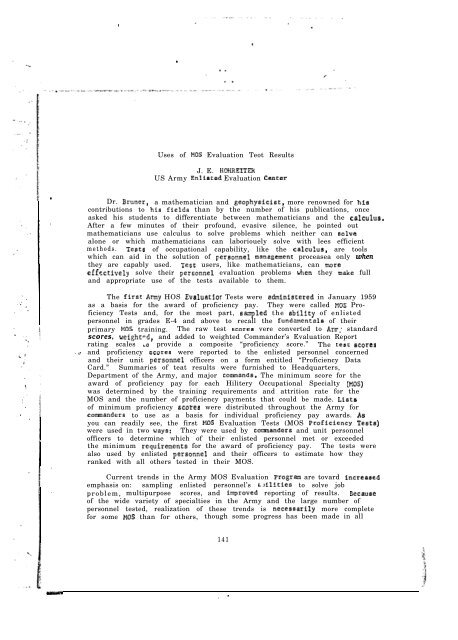Technical Report - International Military Testing Association
Technical Report - International Military Testing Association
Technical Report - International Military Testing Association
Create successful ePaper yourself
Turn your PDF publications into a flip-book with our unique Google optimized e-Paper software.
.<br />
,<br />
.<br />
.<br />
-<br />
.<br />
.<br />
Uses of NOS Evaluation Teot Results<br />
J. E. HMREITM<br />
US Army Enlieted Evaluation Center<br />
Dr. Bruner, a mathematician and geophyoicist, more renowned for hie<br />
contributions to hi8 fields than by the number of his publications, once<br />
asked his students to differentiate between mathematicians and the colculur.<br />
After a few minutes of their profound, evasive silence, he pointed out<br />
mathematicians use calculus to solve problems which neither can solve<br />
alone or which mathematicians can laboriouely solve with lees efficient<br />
methods. Test6 of occupational capability, like the calcu?u.s, are tools<br />
which can aid in the solution of per?onnel management proceasea only when<br />
they are capably used. TeGt users, like mathematicians, can more<br />
effectively solve their perconnel evaluation problems &en they make full<br />
and appropriate use of the tests available to them.<br />
The fir-et Army HOS Evaluatior Tests were edmlniotered in January 1959<br />
as a basis for the award of proficiency pay. They were called HOS Proficiency<br />
Tests and, for the most part, s-led the abil?ty of enlisted<br />
personnel in grades E-4 and above to recall the fundmcntols of their<br />
primary HOS training. The raw test 6corea vere converted to Arm; standard<br />
scores, weightnd, and added to weighted Commander’s Evaluation <strong>Report</strong><br />
rating scales co provide a composite “proficiency score.” The te6t acores<br />
. .., and proficiency acores were reported to the enlisted personnel concerned<br />
and their unit personnel officers on a form entitled “Proficiency Data<br />
Card.” Summaries of teat results were furnished to Headquarters,<br />
Department of the Army, and major cousnands. The minimum score for the<br />
award of proficiency pay for each Hilitery Occupational Specialty (!%3S)<br />
was determined by the training requirements and attrition rate for the<br />
MOS and the number of proficiency payments that could be made. Lists<br />
of minimum proficiency score8 were distributed throughout the Army for<br />
corrnnanders to use as a basis for individual proficiency pay awards. Ae<br />
you can readily see, the first MS Evaluation Tests (MOS Proficiency Teets)<br />
were used in two vaye: They were used by cormmurders and unit personnel<br />
officers to determine which of their enlisted personnel met or exceeded<br />
the minimum rcquiremcnts for the award of proficiency pay. The tests were<br />
also used by enlisted perrronnel and their officers to estimate how they<br />
ranked with all others tested in their MOS.<br />
Current trends in the Army MOS Evaluation Program are tovard increaeed<br />
emphasis on: sampling enlisted personnel’s LJilitieo to solve job<br />
problem, multipurpose scores, and improved reporting of results. Becauee<br />
of the wide variety of specialties in the Army and the large number of<br />
personnel tested, realization of these trends is necesearily more complete<br />
for some NOS than for others, though some progress has been made in all<br />
141<br />
.*









